Engineering Economics Assignment: Investment Analysis and NPV
VerifiedAdded on 2022/09/10
|8
|1107
|15
Homework Assignment
AI Summary
This Engineering Economics assignment analyzes various investment scenarios using techniques like Net Present Value (NPV), Payback Period, and Profitability Index. The assignment begins with a cash flow analysis, considering inflows and outflows to determine the net cash flow over a five-year period. The second question evaluates the Briarcliff Stove Company's new product line, calculating its NPV, payback period, and profitability index under different discount rates. The analysis indicates the project's feasibility based on the financial metrics. Finally, the third question assesses the Carbide Chemical Company's machine replacement proposal, determining its NPV, payback period, and profitability index to evaluate the project's acceptability. The solutions include detailed calculations, tables, and interpretations of the financial results, providing a comprehensive understanding of the investment decision-making process. The assignment demonstrates the application of economic principles in engineering projects.
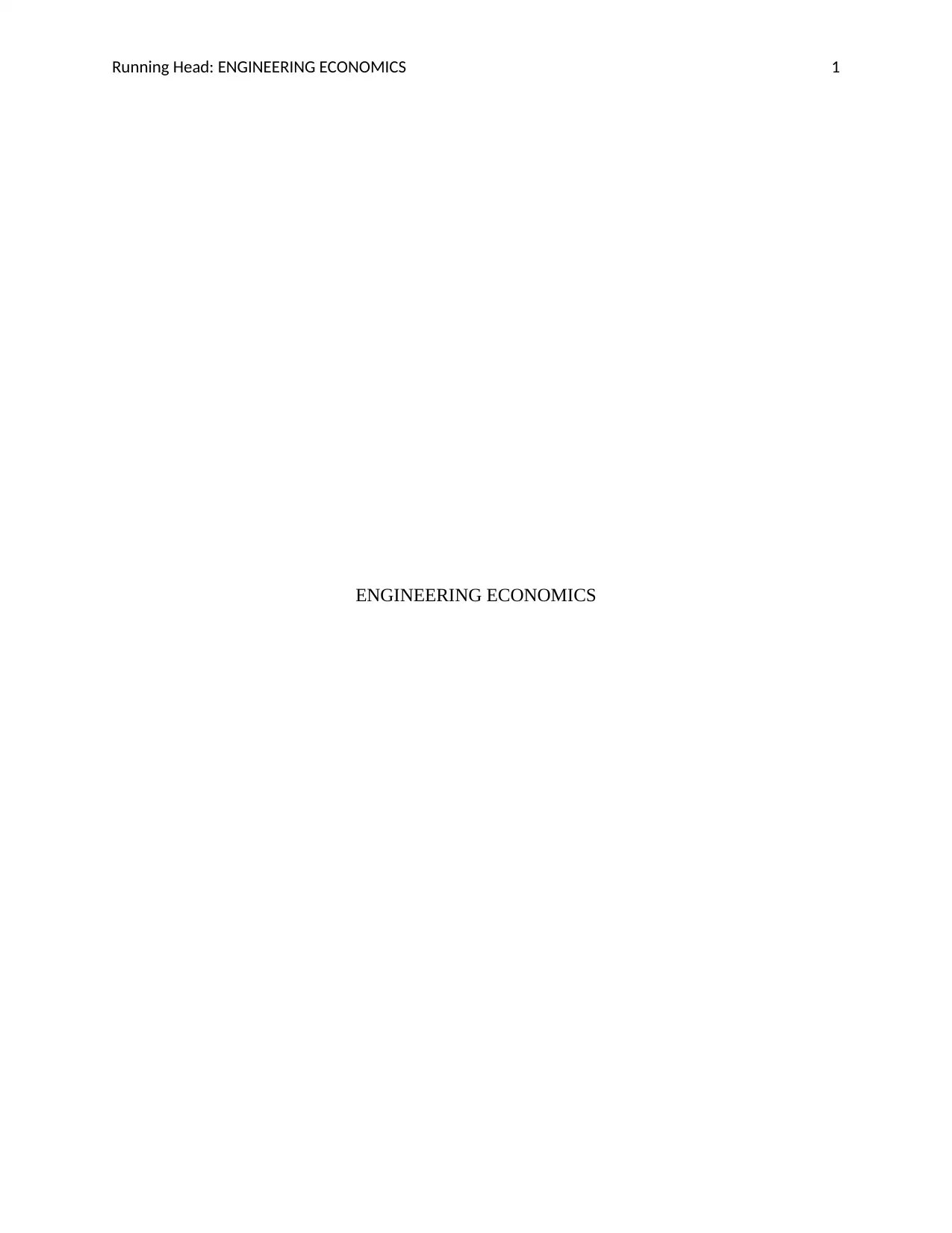
Running Head: ENGINEERING ECONOMICS 1
ENGINEERING ECONOMICS
ENGINEERING ECONOMICS
Paraphrase This Document
Need a fresh take? Get an instant paraphrase of this document with our AI Paraphraser
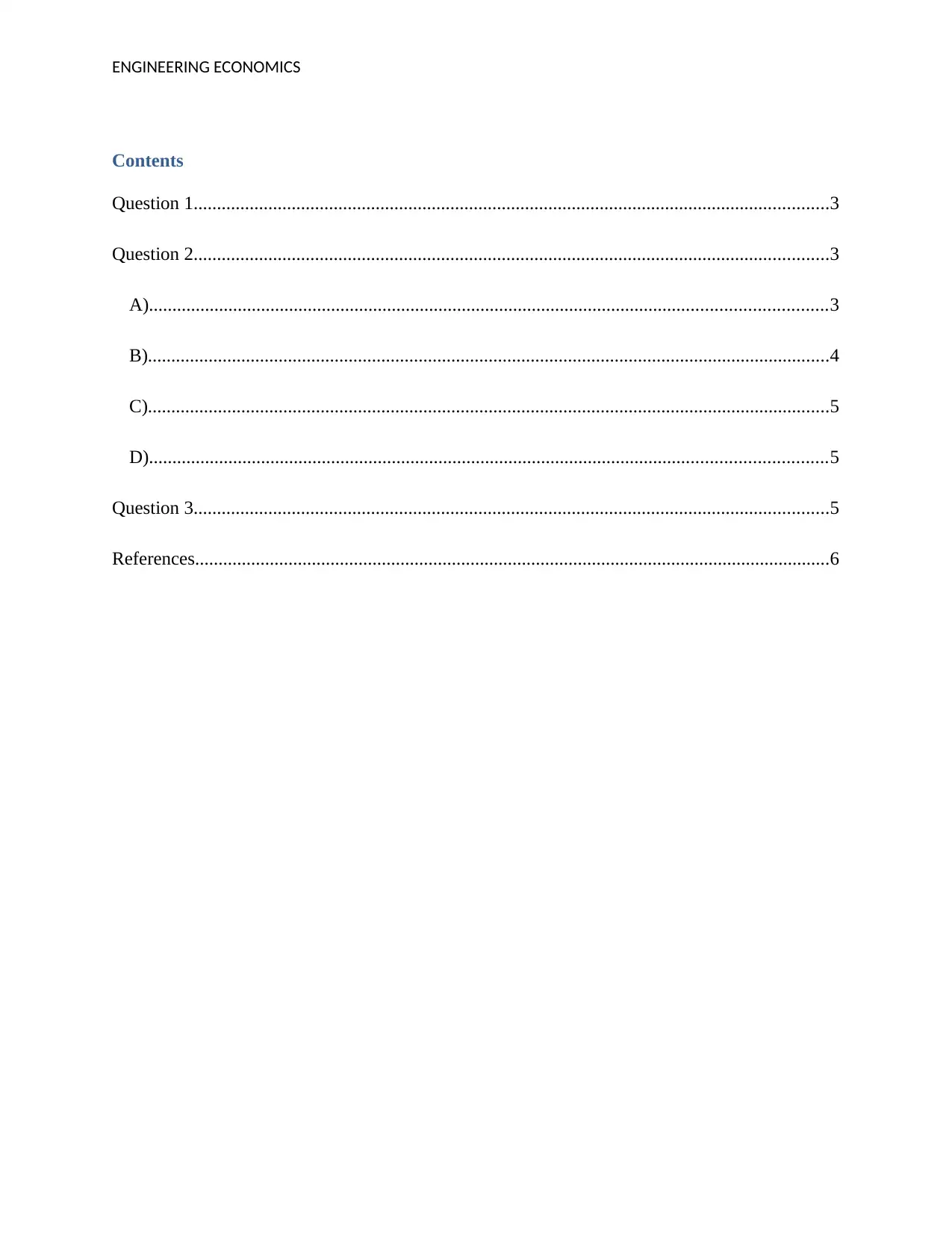
ENGINEERING ECONOMICS
Contents
Question 1........................................................................................................................................3
Question 2........................................................................................................................................3
A).................................................................................................................................................3
B)..................................................................................................................................................4
C)..................................................................................................................................................5
D).................................................................................................................................................5
Question 3........................................................................................................................................5
References........................................................................................................................................6
Contents
Question 1........................................................................................................................................3
Question 2........................................................................................................................................3
A).................................................................................................................................................3
B)..................................................................................................................................................4
C)..................................................................................................................................................5
D).................................................................................................................................................5
Question 3........................................................................................................................................5
References........................................................................................................................................6
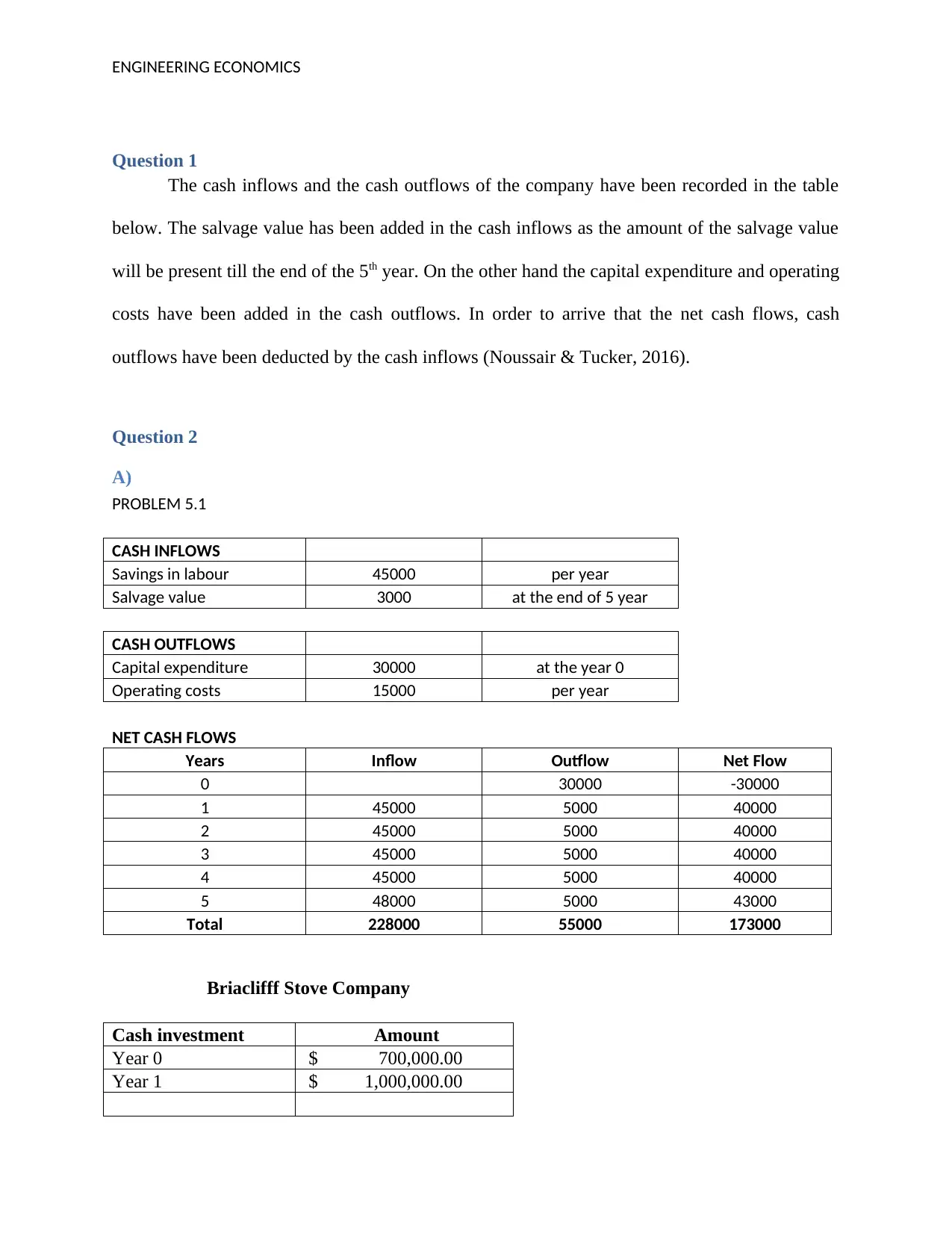
ENGINEERING ECONOMICS
Question 1
The cash inflows and the cash outflows of the company have been recorded in the table
below. The salvage value has been added in the cash inflows as the amount of the salvage value
will be present till the end of the 5th year. On the other hand the capital expenditure and operating
costs have been added in the cash outflows. In order to arrive that the net cash flows, cash
outflows have been deducted by the cash inflows (Noussair & Tucker, 2016).
Question 2
A)
PROBLEM 5.1
CASH INFLOWS
Savings in labour 45000 per year
Salvage value 3000 at the end of 5 year
CASH OUTFLOWS
Capital expenditure 30000 at the year 0
Operating costs 15000 per year
NET CASH FLOWS
Years Inflow Outflow Net Flow
0 30000 -30000
1 45000 5000 40000
2 45000 5000 40000
3 45000 5000 40000
4 45000 5000 40000
5 48000 5000 43000
Total 228000 55000 173000
Briaclifff Stove Company
Cash investment Amount
Year 0 $ 700,000.00
Year 1 $ 1,000,000.00
Question 1
The cash inflows and the cash outflows of the company have been recorded in the table
below. The salvage value has been added in the cash inflows as the amount of the salvage value
will be present till the end of the 5th year. On the other hand the capital expenditure and operating
costs have been added in the cash outflows. In order to arrive that the net cash flows, cash
outflows have been deducted by the cash inflows (Noussair & Tucker, 2016).
Question 2
A)
PROBLEM 5.1
CASH INFLOWS
Savings in labour 45000 per year
Salvage value 3000 at the end of 5 year
CASH OUTFLOWS
Capital expenditure 30000 at the year 0
Operating costs 15000 per year
NET CASH FLOWS
Years Inflow Outflow Net Flow
0 30000 -30000
1 45000 5000 40000
2 45000 5000 40000
3 45000 5000 40000
4 45000 5000 40000
5 48000 5000 43000
Total 228000 55000 173000
Briaclifff Stove Company
Cash investment Amount
Year 0 $ 700,000.00
Year 1 $ 1,000,000.00
⊘ This is a preview!⊘
Do you want full access?
Subscribe today to unlock all pages.

Trusted by 1+ million students worldwide
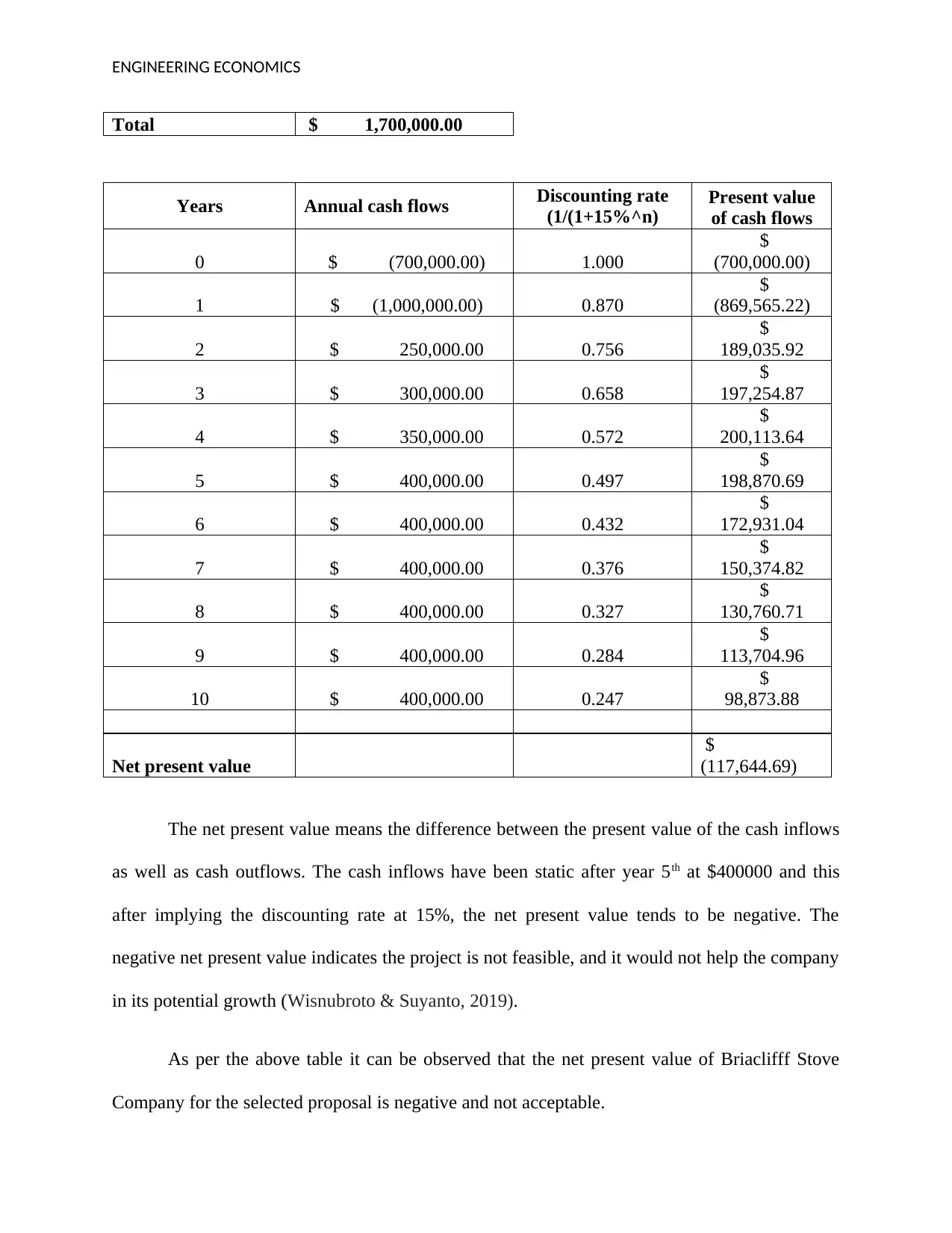
ENGINEERING ECONOMICS
Total $ 1,700,000.00
Years Annual cash flows Discounting rate
(1/(1+15%^n)
Present value
of cash flows
0 $ (700,000.00) 1.000
$
(700,000.00)
1 $ (1,000,000.00) 0.870
$
(869,565.22)
2 $ 250,000.00 0.756
$
189,035.92
3 $ 300,000.00 0.658
$
197,254.87
4 $ 350,000.00 0.572
$
200,113.64
5 $ 400,000.00 0.497
$
198,870.69
6 $ 400,000.00 0.432
$
172,931.04
7 $ 400,000.00 0.376
$
150,374.82
8 $ 400,000.00 0.327
$
130,760.71
9 $ 400,000.00 0.284
$
113,704.96
10 $ 400,000.00 0.247
$
98,873.88
Net present value
$
(117,644.69)
The net present value means the difference between the present value of the cash inflows
as well as cash outflows. The cash inflows have been static after year 5th at $400000 and this
after implying the discounting rate at 15%, the net present value tends to be negative. The
negative net present value indicates the project is not feasible, and it would not help the company
in its potential growth (Wisnubroto & Suyanto, 2019).
As per the above table it can be observed that the net present value of Briaclifff Stove
Company for the selected proposal is negative and not acceptable.
Total $ 1,700,000.00
Years Annual cash flows Discounting rate
(1/(1+15%^n)
Present value
of cash flows
0 $ (700,000.00) 1.000
$
(700,000.00)
1 $ (1,000,000.00) 0.870
$
(869,565.22)
2 $ 250,000.00 0.756
$
189,035.92
3 $ 300,000.00 0.658
$
197,254.87
4 $ 350,000.00 0.572
$
200,113.64
5 $ 400,000.00 0.497
$
198,870.69
6 $ 400,000.00 0.432
$
172,931.04
7 $ 400,000.00 0.376
$
150,374.82
8 $ 400,000.00 0.327
$
130,760.71
9 $ 400,000.00 0.284
$
113,704.96
10 $ 400,000.00 0.247
$
98,873.88
Net present value
$
(117,644.69)
The net present value means the difference between the present value of the cash inflows
as well as cash outflows. The cash inflows have been static after year 5th at $400000 and this
after implying the discounting rate at 15%, the net present value tends to be negative. The
negative net present value indicates the project is not feasible, and it would not help the company
in its potential growth (Wisnubroto & Suyanto, 2019).
As per the above table it can be observed that the net present value of Briaclifff Stove
Company for the selected proposal is negative and not acceptable.
Paraphrase This Document
Need a fresh take? Get an instant paraphrase of this document with our AI Paraphraser
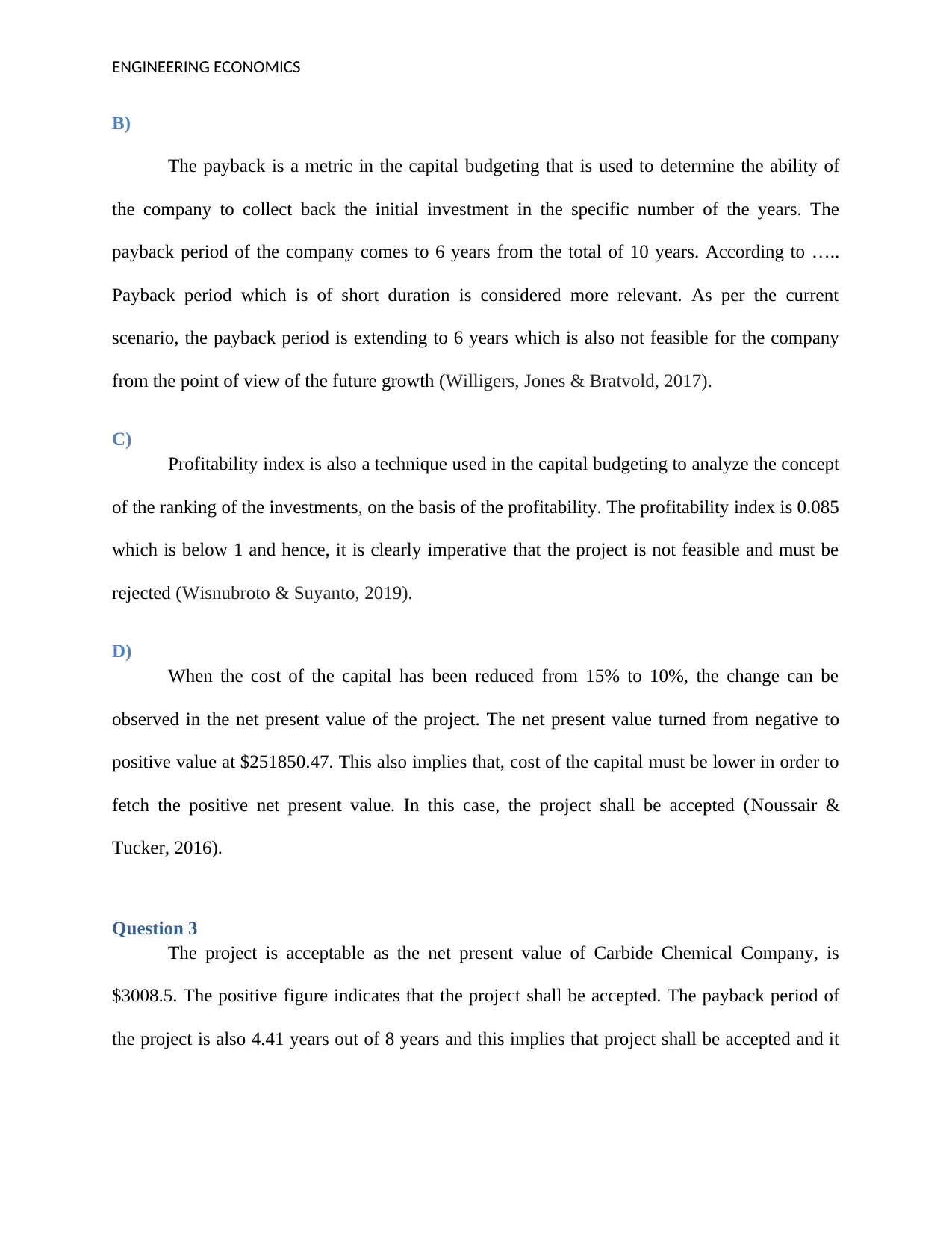
ENGINEERING ECONOMICS
B)
The payback is a metric in the capital budgeting that is used to determine the ability of
the company to collect back the initial investment in the specific number of the years. The
payback period of the company comes to 6 years from the total of 10 years. According to …..
Payback period which is of short duration is considered more relevant. As per the current
scenario, the payback period is extending to 6 years which is also not feasible for the company
from the point of view of the future growth (Willigers, Jones & Bratvold, 2017).
C)
Profitability index is also a technique used in the capital budgeting to analyze the concept
of the ranking of the investments, on the basis of the profitability. The profitability index is 0.085
which is below 1 and hence, it is clearly imperative that the project is not feasible and must be
rejected (Wisnubroto & Suyanto, 2019).
D)
When the cost of the capital has been reduced from 15% to 10%, the change can be
observed in the net present value of the project. The net present value turned from negative to
positive value at $251850.47. This also implies that, cost of the capital must be lower in order to
fetch the positive net present value. In this case, the project shall be accepted (Noussair &
Tucker, 2016).
Question 3
The project is acceptable as the net present value of Carbide Chemical Company, is
$3008.5. The positive figure indicates that the project shall be accepted. The payback period of
the project is also 4.41 years out of 8 years and this implies that project shall be accepted and it
B)
The payback is a metric in the capital budgeting that is used to determine the ability of
the company to collect back the initial investment in the specific number of the years. The
payback period of the company comes to 6 years from the total of 10 years. According to …..
Payback period which is of short duration is considered more relevant. As per the current
scenario, the payback period is extending to 6 years which is also not feasible for the company
from the point of view of the future growth (Willigers, Jones & Bratvold, 2017).
C)
Profitability index is also a technique used in the capital budgeting to analyze the concept
of the ranking of the investments, on the basis of the profitability. The profitability index is 0.085
which is below 1 and hence, it is clearly imperative that the project is not feasible and must be
rejected (Wisnubroto & Suyanto, 2019).
D)
When the cost of the capital has been reduced from 15% to 10%, the change can be
observed in the net present value of the project. The net present value turned from negative to
positive value at $251850.47. This also implies that, cost of the capital must be lower in order to
fetch the positive net present value. In this case, the project shall be accepted (Noussair &
Tucker, 2016).
Question 3
The project is acceptable as the net present value of Carbide Chemical Company, is
$3008.5. The positive figure indicates that the project shall be accepted. The payback period of
the project is also 4.41 years out of 8 years and this implies that project shall be accepted and it
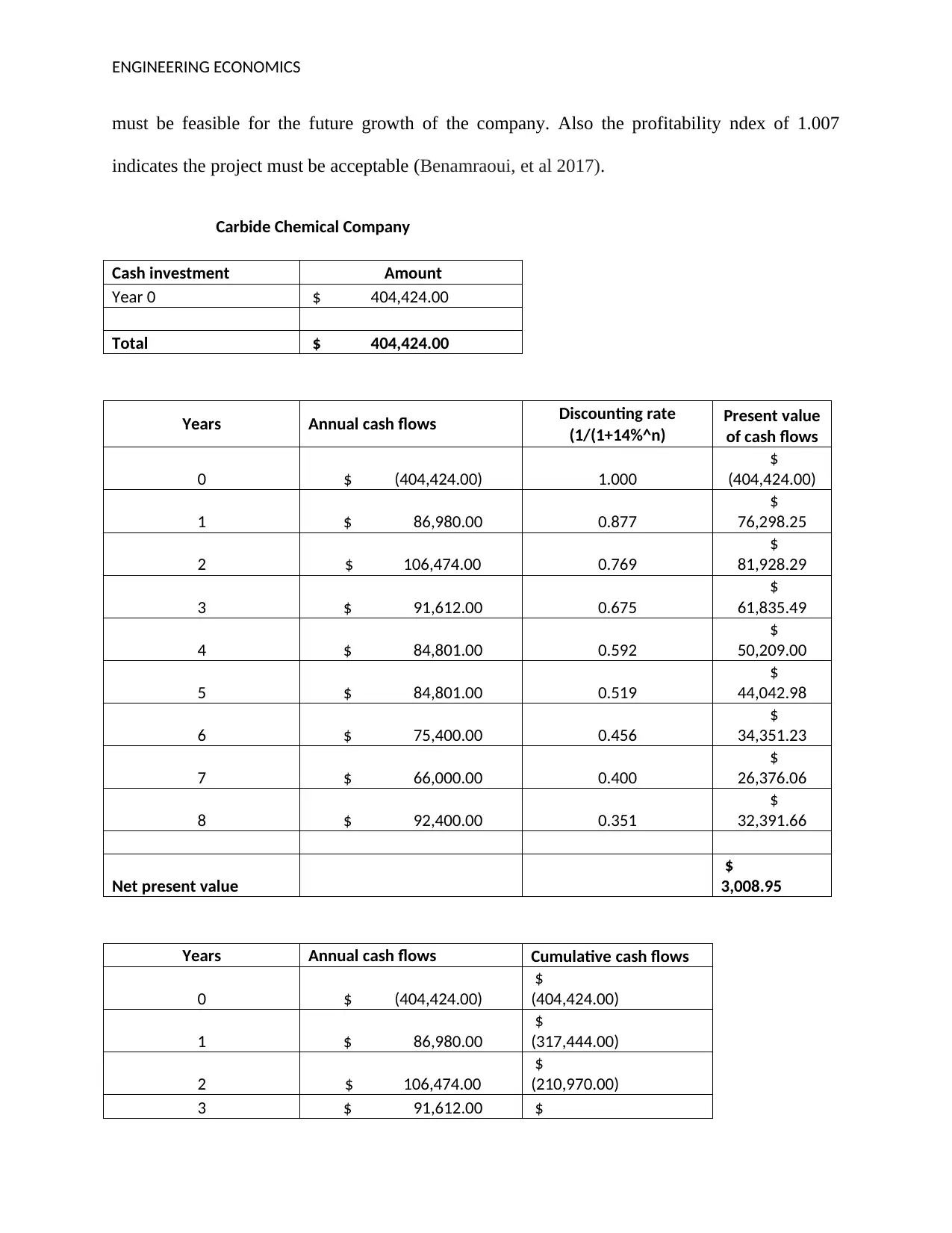
ENGINEERING ECONOMICS
must be feasible for the future growth of the company. Also the profitability ndex of 1.007
indicates the project must be acceptable (Benamraoui, et al 2017).
Carbide Chemical Company
Cash investment Amount
Year 0 $ 404,424.00
Total $ 404,424.00
Years Annual cash flows Discounting rate
(1/(1+14%^n)
Present value
of cash flows
0 $ (404,424.00) 1.000
$
(404,424.00)
1 $ 86,980.00 0.877
$
76,298.25
2 $ 106,474.00 0.769
$
81,928.29
3 $ 91,612.00 0.675
$
61,835.49
4 $ 84,801.00 0.592
$
50,209.00
5 $ 84,801.00 0.519
$
44,042.98
6 $ 75,400.00 0.456
$
34,351.23
7 $ 66,000.00 0.400
$
26,376.06
8 $ 92,400.00 0.351
$
32,391.66
Net present value
$
3,008.95
Years Annual cash flows Cumulative cash flows
0 $ (404,424.00)
$
(404,424.00)
1 $ 86,980.00
$
(317,444.00)
2 $ 106,474.00
$
(210,970.00)
3 $ 91,612.00 $
must be feasible for the future growth of the company. Also the profitability ndex of 1.007
indicates the project must be acceptable (Benamraoui, et al 2017).
Carbide Chemical Company
Cash investment Amount
Year 0 $ 404,424.00
Total $ 404,424.00
Years Annual cash flows Discounting rate
(1/(1+14%^n)
Present value
of cash flows
0 $ (404,424.00) 1.000
$
(404,424.00)
1 $ 86,980.00 0.877
$
76,298.25
2 $ 106,474.00 0.769
$
81,928.29
3 $ 91,612.00 0.675
$
61,835.49
4 $ 84,801.00 0.592
$
50,209.00
5 $ 84,801.00 0.519
$
44,042.98
6 $ 75,400.00 0.456
$
34,351.23
7 $ 66,000.00 0.400
$
26,376.06
8 $ 92,400.00 0.351
$
32,391.66
Net present value
$
3,008.95
Years Annual cash flows Cumulative cash flows
0 $ (404,424.00)
$
(404,424.00)
1 $ 86,980.00
$
(317,444.00)
2 $ 106,474.00
$
(210,970.00)
3 $ 91,612.00 $
⊘ This is a preview!⊘
Do you want full access?
Subscribe today to unlock all pages.

Trusted by 1+ million students worldwide
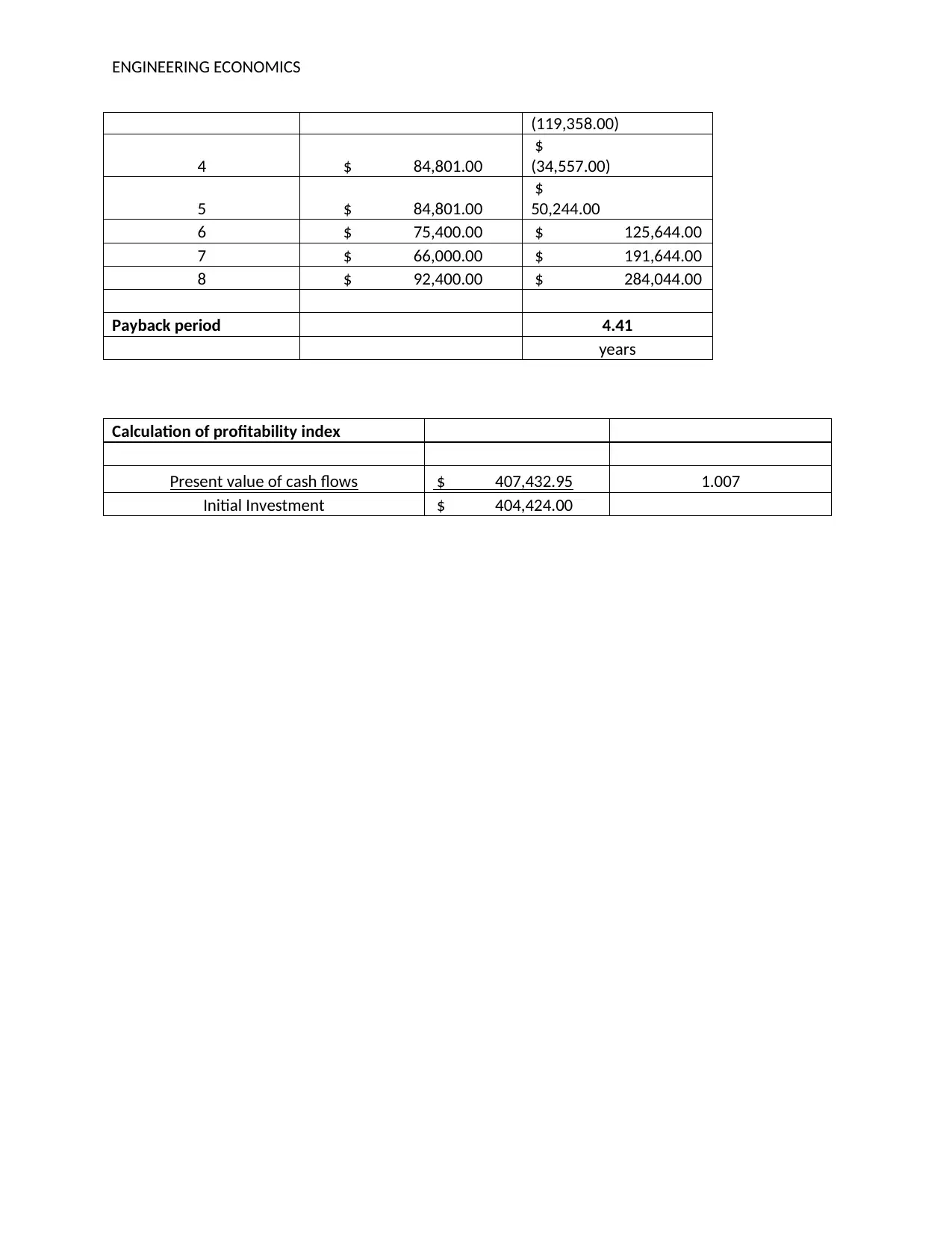
ENGINEERING ECONOMICS
(119,358.00)
4 $ 84,801.00
$
(34,557.00)
5 $ 84,801.00
$
50,244.00
6 $ 75,400.00 $ 125,644.00
7 $ 66,000.00 $ 191,644.00
8 $ 92,400.00 $ 284,044.00
Payback period 4.41
years
Calculation of profitability index
Present value of cash flows $ 407,432.95 1.007
Initial Investment $ 404,424.00
(119,358.00)
4 $ 84,801.00
$
(34,557.00)
5 $ 84,801.00
$
50,244.00
6 $ 75,400.00 $ 125,644.00
7 $ 66,000.00 $ 191,644.00
8 $ 92,400.00 $ 284,044.00
Payback period 4.41
years
Calculation of profitability index
Present value of cash flows $ 407,432.95 1.007
Initial Investment $ 404,424.00
Paraphrase This Document
Need a fresh take? Get an instant paraphrase of this document with our AI Paraphraser
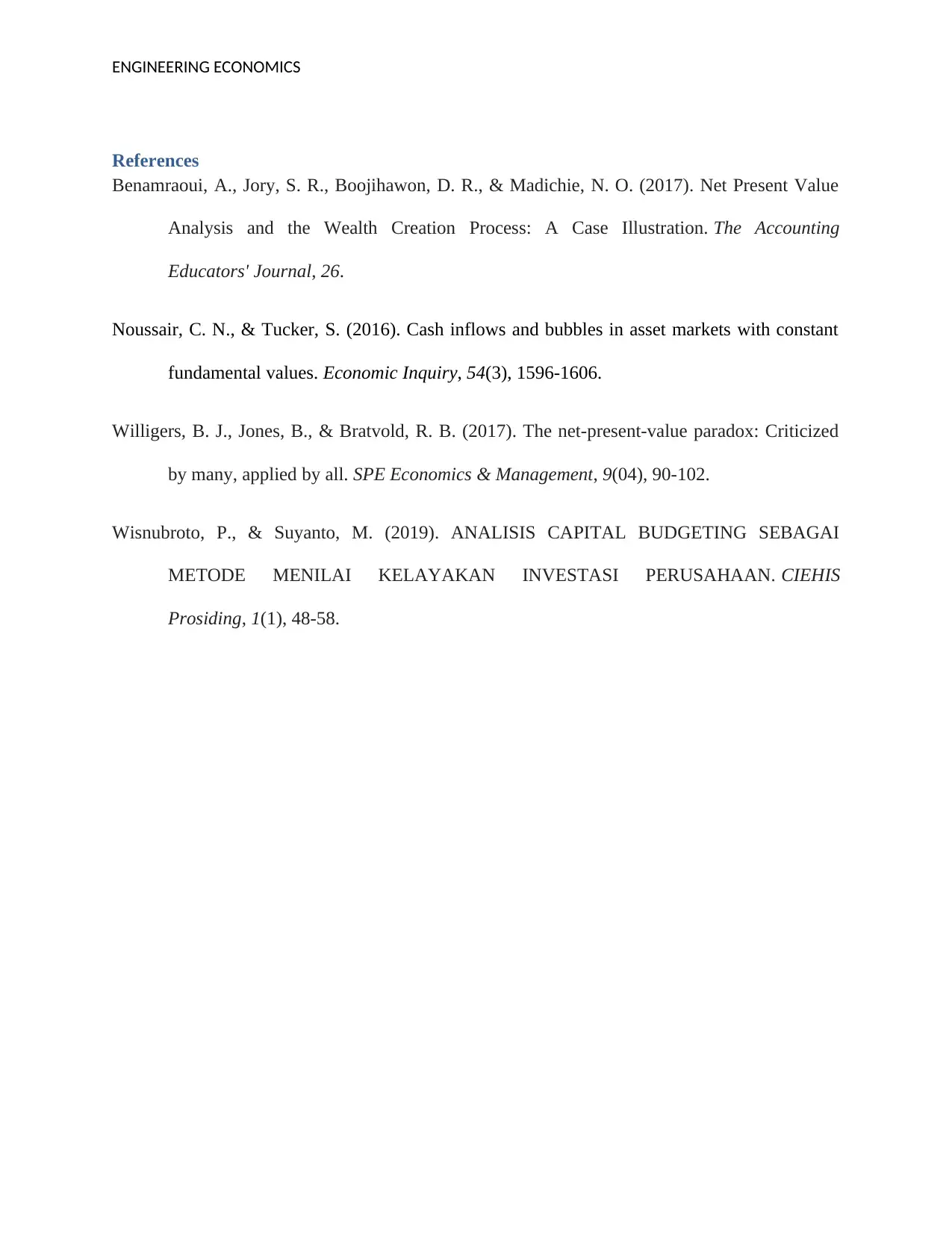
ENGINEERING ECONOMICS
References
Benamraoui, A., Jory, S. R., Boojihawon, D. R., & Madichie, N. O. (2017). Net Present Value
Analysis and the Wealth Creation Process: A Case Illustration. The Accounting
Educators' Journal, 26.
Noussair, C. N., & Tucker, S. (2016). Cash inflows and bubbles in asset markets with constant
fundamental values. Economic Inquiry, 54(3), 1596-1606.
Willigers, B. J., Jones, B., & Bratvold, R. B. (2017). The net-present-value paradox: Criticized
by many, applied by all. SPE Economics & Management, 9(04), 90-102.
Wisnubroto, P., & Suyanto, M. (2019). ANALISIS CAPITAL BUDGETING SEBAGAI
METODE MENILAI KELAYAKAN INVESTASI PERUSAHAAN. CIEHIS
Prosiding, 1(1), 48-58.
References
Benamraoui, A., Jory, S. R., Boojihawon, D. R., & Madichie, N. O. (2017). Net Present Value
Analysis and the Wealth Creation Process: A Case Illustration. The Accounting
Educators' Journal, 26.
Noussair, C. N., & Tucker, S. (2016). Cash inflows and bubbles in asset markets with constant
fundamental values. Economic Inquiry, 54(3), 1596-1606.
Willigers, B. J., Jones, B., & Bratvold, R. B. (2017). The net-present-value paradox: Criticized
by many, applied by all. SPE Economics & Management, 9(04), 90-102.
Wisnubroto, P., & Suyanto, M. (2019). ANALISIS CAPITAL BUDGETING SEBAGAI
METODE MENILAI KELAYAKAN INVESTASI PERUSAHAAN. CIEHIS
Prosiding, 1(1), 48-58.
1 out of 8
Related Documents
Your All-in-One AI-Powered Toolkit for Academic Success.
+13062052269
info@desklib.com
Available 24*7 on WhatsApp / Email
![[object Object]](/_next/static/media/star-bottom.7253800d.svg)
Unlock your academic potential
Copyright © 2020–2025 A2Z Services. All Rights Reserved. Developed and managed by ZUCOL.





